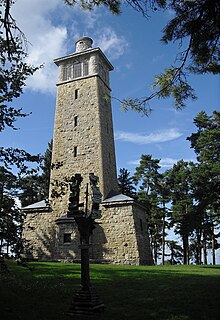Caroline Reuss to Greiz
Caroline Elisabeth Ida Reuss zu Greiz (* July 13, 1884 in Greiz ; † January 17, 1905 in Weimar ) was a Princess Reuss of Greiz and by marriage Grand Duchess of Saxe-Weimar-Eisenach .
Life
Princess Caroline was a daughter of Prince Heinrich XXII. Reuss zu Greiz (1846–1902) from his marriage to Ida (1852–1891), daughter of Prince Adolf I of Schaumburg-Lippe .
Caroline married Grand Duke Wilhelm Ernst of Saxe-Weimar-Eisenach (1876–1923) on April 30, 1903 in Bückeburg . At the time of the wedding, Caroline was already an orphan and her brother was incapable of government, which is why the wedding was organized by the relatives in Bückeburg. In addition to Queen Wilhelmina of the Netherlands , Kaiser Wilhelm II was also present at the wedding .
Caroline had resisted this marriage project, presumably, like her two older sisters, she had already been in a relationship with a man below her class. At the hen party, she treated her groom so badly that he went to the emperor to resign from the marriage project. But he forbade this scandal and ordered the Grand Duke as supreme warlord: “We'll get married!” The Kaiser is said to have written to Wilhelm Ernst: “If I, the German Kaiser, come to your wedding, then you cannot explain the evening before, you didn't want to get married. With your oath of allegiance you have pledged your loyalty and I command you to marry tomorrow. "

The childless marriage with the choleric Wilhelm Ernst turned out to be extremely unhappy. There were violent scenes; Caroline thought of escape and fell into depression. After her plan to secretly leave Weimar became apparent, her confidants, her lady-in-waiting, Countess Anni von Bernstorff and her chief steward, Count Medem, were removed. Because of her social and charitable work, Caroline was referred to by the population as the “Star of Weimar”. With their support, the Weimar Artists Association was founded with Max Liebermann , Max Klinger and Harry Graf Kessler . Caroline was considered a patron of Henry van de Velde .

Caroline died at the age of 20 almost two years after the wedding - officially of severe pneumonia. However, various sources assume that the Grand Duchess took her own life. Caroline was buried as the last member of the House of Saxony-Weimar in the Weimar Princely Crypt. Harry Graf Kessler wrote about the couple in 1903, even before his falling out with Wilhelm Ernst: "The Grand Duchess naive and spontaneous in enjoying art; at first there was always a small battle between etiquette and impulsive devotion; this then always victorious. Great naturalness. The Grand Duke is deliberate and colder, but attentive and determined to go along. "
Appreciations

The Carolinenheim in Apolda , the Carolinenstraße branching off there, the Carolinenturm on the Kötsch near Weimar, the Carolinenpromenade in Weimar and the Carolinenbrücke in Eisenach are named after the Grand Duchess .
In 1905, the Kurbad Eisenach GmbH was founded in Eisenach : The company acquired the rights of use for the mineral water spring at Wilhelmsglücksbrunn, which was designated as the Grand Duchess- Karolinen- Quelle . On July 8, 1906, the spa was opened with the specially built foyer in Eisenach , whose healing water was pumped from the spring location, the Karolinen spring, through a 14-kilometer-long water pipe. The spa was closed in 1938.
See also
literature
- Bernhard Post, Dietrich Werner: rulers in the turn of the ages. Wilhelm Ernst of Saxe-Weimar-Eisenach. 1876-1923. Glaux, Jena 2006, ISBN 3-931743-94-2 .
- Erika von Watzdorf-Bachoff: In the change and in the transformation of time. A life from 1878 to (1963). Edited from the estate by Reinhard R. Doerries. Steiner, Stuttgart 1997, ISBN 3-515-07062-1 , p. 120.
- Silke Ellenbeck: My death begins in suffering. The short life of Grand Duchess Caroline of Saxe-Weimar-Eisenach, Princess of Reuss, Ä. L .. 1884–1905. DeBehr Verlag, Radeberg 2017, ISBN 978-3-95753-437-8 .
Web links
- “Kosmos Weimar”: Myth Caroline - The Star of Weimar by Manuel Schwarz, accessed on January 26, 2020
- Carolinenheim Apolda Foundation: 110 years Carolinenheim. Retrieved January 26, 2020 .
- Kötschberggemeinde e. V .: The Carolinenturm on the Kötsch , accessed on January 26, 2020
References and comments
- ↑ or Reuss older line
- ↑ Erika von Watzdorf-Bachoff: In the change and in the transformation of time. 1997, p. 120.
- ↑ O. Lindeman: Vorst Schemering. De families, de onderlinge verhoudingen, de huwelijken, de paleizen en hoven en de val der Europese dynastieën met wat daaraan voorafging en wat overbleef. Europese Library, Zaltbommel 1974, p. 136.
- ^ Henry van de Velde: PDF. Pp. 240–243, Caroline Reuss zu Greiz in Weimar. Retrieved April 26, 2020 .
- ↑ pickelhauben.net: The Thuringian Duchies and Principalities
- ^ Allan Raymond: Monarchies of Europe: Saxe-Weimar-Eisenach Royal Family . Archived from the original on October 25, 2012 ; Retrieved September 20, 2013 .
- ↑ Myth Caroline | Classic Foundation blog. In: blog.klassik-stiftung.de. Retrieved July 8, 2016 .
- ↑ https://stiftung-carolinenheim-apolda.de/stiftung/geschichte.php , accessed on January 26, 2020
- ↑ http://www.wilhelmsgluecksbrunn.de/das-stiftsgut/geschichte.html
| personal data | |
|---|---|
| SURNAME | Caroline Reuss to Greiz |
| ALTERNATIVE NAMES | Caroline Reuss older line |
| BRIEF DESCRIPTION | Grand Duchess of Saxe-Weimar-Eisenach |
| DATE OF BIRTH | July 13, 1884 |
| PLACE OF BIRTH | Greiz |
| DATE OF DEATH | January 17, 1905 |
| Place of death | Weimar |



